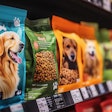
Plants have proven effective versus zombies, but how well do plants compare against their ancient frenemies, insects, as novel pet food protein sources? As consumer demand for sustainable pet food ingredients rises, formulators look further afield, often into farm fields, to find novel protein sources from crops. Likewise, insects have risen as an alternative pet food protein source with environmental credentials.
Plants and insects each have unique sustainability advantages, yet differ in key ways. A closer examination of these differences can guide pet food formulators in making environmentally conscious ingredient choices.
Environmental effects of plants compared to insects
Plant-based proteins, derived from sources like peas, lentils, soy and chickpeas, create a smaller carbon footprint compared to meat-based proteins. These crops typically require less water, land and other resources to produce a similar amount of protein than four- and two-legged animals.
Unlike insects, plants can be cultivated on a large scale using existing agricultural infrastructure. Whereas arthropod farming is still in its larval stage. Insect protein and oil production facilities are not nearly as widespread as legume fields. While several large facilities are now operational and others are in the works, insect production volume lags far behind traditional protein sources. Plants can also help sequester carbon from the atmosphere when their roots, stems and other crop residues remain on fields.
However, plant-based proteins are not without environmental drawbacks. Crop cultivation can lead to soil degradation, biodiversity loss, water pollution and pesticide contamination. Monoculture farming of row crops used as plant-based proteins can contribute to these issues. Sustainable farming practices can mitigate some of these effects, but their use varies widely by region. Likewise, vertical farming can reduce land use and habitat loss to agriculture, but growing crops indoors has similar infrastructure needs to insect farming,
Insects compared to plant resource efficiency
Insect-based proteins from species like black soldier fly larvae and crickets present different sustainability advantages. Insect farming requires less land, water and feed than traditional livestock to produce equivalent amounts of pet food ingredients. Black soldier fly larvae, for example, can be raised on organic waste, such as corn byproducts, reducing waste and facilitating a closed-loop agricultural system and industrial symbiosis. Furthermore, insects emit fewer greenhouse gases than livestock and have a high protein conversion rate, efficiently turning feed into protein with minimal environmental cost. However, building insect production facilities does require resources and land, while producing pollution, including greenhouse gas emissions.
Once those facilities are built, though, insect farming's compact infrastructure requirements allow for high-density production that can be scaled vertically, reducing land use and allowing production in urban or indoor environments. Plant-based proteins depend on expansive tracts of arable land, which may be increasingly limited as the human population grows.
Both plant-based and insect-based proteins offer sustainability benefits. Both will likely continue to contribute to the pet food industry’s drive to preserve what we have for future generations. Plants and insects are two tools in the pet food formulator’s toolbox but with distinctions. By considering these differences, formulators can better align their products with the evolving preferences of eco-conscious pet owners.

















